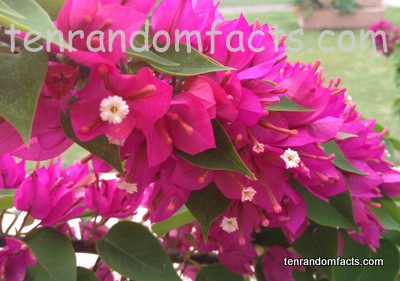Everyone look at me!
- Bougainvilleas are a woody vine from the family Nyctaginaceae, which is the family of Four O’Clock plants.
- Bougainvilleas are also known as Napoleón, veranera, trinitaria, Santa Rita and papelillo.
- South America is the native home of bougainvillea plants, and in its natural tropical growing environment, it flowers all year.
- Bougainvilleas grow 1-12 metres (3 to 39 feet) in height depending on the species, and can be grown in pots, as a bonsai, in hanging baskets, along walls, over trellises, as a hedge and other places in the garden.
- Bougainvilleas were first recorded by the Europeans, by French botanist Philibert Commerçon, in the 1760s.
- The bougainvillea was named by Commerçon, after the French admiral, Loui-Antoine de Bougainville, who was an explorer, and whom Commerçon had joined for an expedition around the world.
- Bougainvilleas are evergreen and grow well in warm to hot climates, although they can become dormant and lose their leaves in winter if it becomes too cold, and they can be damaged by frosts.
- Bougainvillea flowers are generally white or cream coloured, and are sometimes overlooked, as the papery bracts surrounding them easily distract with their vibrant colours of pink, white, orange, purple or burgundy.
- Bougainvilleas need good drainage, are very hardy once established, can tolerate salty environments, and are not usually attacked by pests.
- Bougainvilleas are a popular garden plant, due to their stunningly coloured bracts and their versatility in the garden.





